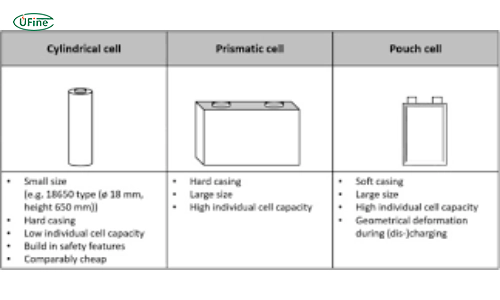Battery packages are vital components that power various devices, from smartphones to electric vehicles. Understanding their construction and design can help us make informed choices for better performance and longer lifespan. Let’s dive into the world of battery packages and uncover how they work and what factors influence their effectiveness.
Part 1. What are battery packages?
A battery package is a complete unit that houses one or more battery cells and necessary operation components. These components typically include battery cells, casing, terminals, and sometimes management systems like Battery Management Systems (BMS). The battery cells are the core energy storage units enclosed within a protective casing that shields them from external impacts and provides structural integrity. Terminals are the connection points for electrical current flow, allowing the battery package to interface with external devices or systems.
Types of Battery Packages
There are several types of battery packages commonly used across industries:
- Cylindrical battery packages: These batteries feature a cylindrical shape, and manufacturers often use them in consumer electronics due to their reliable performance and ease of manufacturing. Examples include AA, AAA, and 18650 batteries.
- Prismatic battery packages: These batteries have a flat, rectangular shape, making them suitable for applications where space efficiency is crucial, such as laptops and electric vehicles (EVs).
- Pouch battery packages: These batteries use flexible, pouch-like packaging, offering design flexibility and lightweight characteristics. Pouch batteries power smartphones, tablets, and wearable devices extensively.
Comparison of advantages and disadvantages:
- Cylindrical batteries are known for their robustness and cost-effectiveness. Still, they may have lower energy density than prismatic and pouch batteries.
- Prismatic batteries offer higher energy density and better space utilization. Still, they can be more expensive and have cooling and thermal management limitations.
- Pouch batteries excel in flexibility and lightweight design, allowing for custom shapes and sizes. Still, they may require additional protection against physical damage and punctures.
Part 2. Components of battery packages
Battery Cells
Battery cells are the heart of any battery package, responsible for storing and releasing energy. There are several types:
- Manufacturers widely use lithium-ion cells in smartphones, laptops, and electric vehicles due to their high energy density and long lifespan.
- Lead-acid cells are standard in automotive applications for starting engines and are known for their reliability and affordability.
- Nickel-metal hydride cells are used in rechargeable batteries for tools and toys, balancing performance and cost.
The type of battery cell dramatically influences the performance of the battery package, affecting factors like energy storage capacity, charging speed, and overall lifespan.
Battery Casing
The casing of a battery package plays a crucial role in safeguarding its internal components from external hazards. It shields the battery cells against:
- Mechanical damage from impacts or vibrations during use or transportation.
- Moisture and humidity that could otherwise cause corrosion or short circuits.
Materials commonly used for battery casing include:
- Plastic is lightweight, cost-effective, and suitable for consumer electronics.
- Metal alloys like aluminum provide strength and heat dissipation capabilities, ideal for industrial applications.
- Composite materials for specialized needs, offering a balance of durability and weight reduction.
Choosing the suitable casing material depends on the application’s requirements and balancing factors such as durability, weight, and cost.
Battery Terminals
Battery terminals are the connection points that allow the battery package to link with external circuits and devices. They come in various types:
- Screw terminals provide a secure and stable connection, commonly used in stationary applications where reliability is critical.
- Spring terminals offer quick and easy installation for devices requiring frequent battery changes, like remote controls and toys.
Battery terminals are crucial in maintaining electrical continuity and ensuring efficient power transfer between the battery package and external systems. Selecting the appropriate terminal type depends on factors such as ease of assembly, maintenance requirements, and environmental conditions where the battery package will operate.
Part 3. Design considerations for battery packages
Voltage and Capacity Requirements
One of the first things to consider when designing a battery package is the voltage and capacity requirements. Voltage refers to the electrical potential of the battery, while capacity is the amount of energy the battery can store. Here’s how to address these:
- Determine the device’s voltage needs. Most consumer electronics have specific voltage requirements.
- Calculate the required capacity based on usage. For instance, a smartphone might need a battery with a capacity of 3000 mAh for a full day of use.
- Consider battery chemistry. Different types of batteries (like lithium-ion and nickel-metal hydride) offer varying voltage and capacity profiles.
Getting the voltage and capacity right ensures the device runs efficiently and meets user expectations.
Temperature Management
Temperature management is crucial for battery performance and safety, as batteries can generate heat during charging and discharging. Here’s what to keep in mind:
- Use materials that dissipate heat. Aluminum casings, for example, help manage heat effectively.
- Implement cooling systems. Some battery packages, especially electric vehicles, use liquid cooling to stabilize temperatures.
- Include thermal sensors. These sensors monitor the battery’s temperature and trigger safety mechanisms if it gets too hot.
Proper temperature management prevents overheating, prolongs battery life, and ensures safety.
Safety Features
Safety is a top priority in battery design. Batteries can pose risks if not designed correctly. Key safety features include:
- Overcharge protection. It prevents the battery from charging beyond its capacity, which can cause overheating or explosions.
- Short-circuit protection. Stops the flow of electricity in case of a short circuit, preventing damage and potential fire hazards.
- Venting mechanisms. Allows gases to escape safely if the battery overheats, reducing the risk of explosion.
Incorporating these safety features protects users and devices.
Size and Shape
The size and shape of the battery package must fit the device it’s powering. This involves:
- Customizing the battery shape. For example, a thin, rectangular battery might fit better in a tablet. In contrast, a cylindrical battery is more suitable for a flashlight.
- Balancing size with capacity. Larger batteries often hold more energy but must fit within the device’s design constraints.
- Considering weight. This is especially important for portable devices like smartphones and laptops, where a lighter battery improves user experience.
Designing the right size and shape ensures the battery package integrates seamlessly with the device.
Part 4. Battery packages manufacturing processes
Cell Assembly
The process of cell assembly involves several steps to ensure technicians correctly place the battery cells within the battery package:
- Electrode Preparation: The first step involves coating the electrodes (anode and cathode) with active materials, drying them, and cutting them to size.
- Cell Stacking or Winding: In this step, the electrodes and separators are either stacked in layers or wound into a cylindrical shape, depending on the battery design.
- Electrolyte Filling: The electrolyte, the medium for ion transfer, is injected into the cells.
- Sealing: They seal the cells using methods like heat sealing to prevent electrolyte leakage.
Quality control measures are crucial during cell assembly to ensure each cell meets the required standards. These measures include:
- Visual Inspection: Checking for any physical defects in the electrodes and separators.
- Electrochemical Testing: Testing the voltage and capacity of each cell to ensure they meet specifications.
- Leakage Testing: Ensuring the seals are airtight to prevent any electrolyte leakage.
Casing and Encapsulation
Casing and encapsulation protect the internal components of the battery package:
- Casing Manufacturing: Manufacturers typically make casPlasticom plastic or metal. The material is molded or stamped into the required shape. Manufacturers often use aluminum for metal casings because of its strength and lightweight properties.
- Encapsulation: This involves placing the assembled cells into the casing and filling any gaps with insulating materials to prevent short circuits. Manufacturers use materials like epoxy resin for this purpose.
Sealing methods are critical in this stage:
- Heat Sealing: This method uses heat to bond the casing material, creating a solid and airtight seal.
- Ultrasonic Welding: This technique uses high-frequency vibrations to join materials, often used for plastic casings.
Proper sealing ensures that the battery package is leak-proof and can withstand environmental factors, thus enhancing longevity and reliability.
Part 5. Environmental factors and battery packages
Environmental factors play a significant role in the performance and lifespan of battery packages:
- Temperature: Extreme temperatures can affect battery efficiency. High temperatures can cause overheating and reduce lifespan, while low temperatures can decrease performance.
- Humidity: High humidity can lead to corrosion of internal components and short circuits. Therefore, moisture-resistant casings are essential.
- Vibration and Shock: Devices subjected to constant movement, like electric vehicles, need batteries with robust casings to protect against mechanical damage.
To mitigate these environmental impacts, manufacturers:
- Use Thermal Management Systems: These include fans or liquid cooling to maintain optimal temperatures.
- Design Durable Casings: Strong materials like aluminum or plastic help protect against mechanical damage.
- Implement Sealing Techniques: Proper sealing prevents moisture ingress, protecting against humidity-related issues.
These factors ensure battery packages remain reliable and efficient in various environmental conditions.
Part 6. Final words
Battery packages are essential for reliable device performance. Understanding their components and design helps you make better choices. Always choose high-quality battery packages that fit your needs and ensure safety for the best results.
Related Tags:
More Articles

18650 Battery Short Circuit: Risks and Safety Tips
Discover what happens during a 18650 battery short circuit, warning signs, and how to avoid fire, damage, and hazardous failures in your devices.
LiPo Battery Discharge Rate Guide & Calculation Tips
Understand LiPo battery discharge rates, C-ratings, and how to calculate max current. Essential guide for RC, drones, and electronics users.
High‑Capacity 3S LiPo Batteries: 5000 mAh vs. 10000 mAh
Compare 3S LiPo 5000mAh vs 10000mAh batteries by weight, power, and use. Find the best fit for your drone, RC car, or boat setup.
Top 5 Applications for Small 3S LiPo Batteries
Small 3S LiPo batteries power drones, RC gear, wearables, and robotics with high energy and low weight. Making them ideal for compact electronics projects.
Building and Charging Your Own 3S LiPo Pack: A Step‑by‑Step Guide
Learn how to build, balance, and charge a 3S LiPo battery pack safely at home with this complete DIY guide for hobbyists and beginners.




